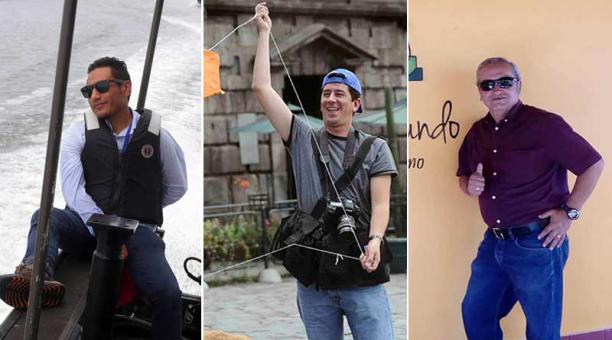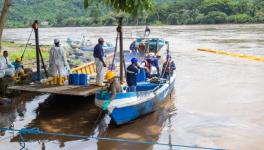In the Line of Duty: Ecuadorian Journalists Covering Narco Related Violence Murdered

After 19 days from their initial disappearance, Ecuadorian and Colombian authorities confirmed on Friday April 13, that the three journalists who had been kidnapped while covering rising violence in the Colombia-Ecuador border region were killed. Javier Ortega, Paúl Rivas, and Efraín Segarra worked for the Ecuadorian newspaper El Comercio and their kidnapping and death have had a strong impact across Ecuadorian society. The situation has also highlighted how the Colombian state still does not have control over important regions of the country and the persistence of narco-violence in Colombia.
The journalists were kidnapped on March 26 by a dissident faction of the FARC (Revolutionary Armed Forces of Colombia), called Oliver Sinisterra, led by Walter Patricio Arizala alias Guacho. They are assumed to have control over the the southernmost region of Nariño and operate in the north of Ecuador in the Esmeraldas province. The Oliver Sinisterra front is one of several dissident groups that decided to not participate in the 2016 Havana Peace Process and demobilize. While some of these groups have claimed an ideological break with the FARC peace process due to the concessions the FARC made to the government in what they see as a departure from the FARC’s principles, others are linked to local criminal groups who control drug production and trafficking; their objective is then not based on continuing the ideological project of the FARC but maintaining a stake in the drug trade.

Nariño, the department where the Oliver Sinisterra dissidents operate, is located in the Pacific South West of Colombia shares a border with the Esmeraldas province in Ecuador and is one of the departments with the highest level of coca production, in 2016 reports showed it is home to 32% of all of the country’s coca crops. Due to its strategic location and coca production, it has always been a disputed territory between Colombia’s numerous armed actors as it has served as a major drug producing and exporting corridor. The municipality of Tumaco also is one of the most violent municipalities in all of Latin America.
In the past year there has been a sharp escalation of violence in the region. As the FARC demobilized and abandoned their areas of influence, conflicts emerged over who would have control over this important region and its key role in the drug trade, an area which the Colombian government still does not control. The violence in the region has spilled over the borders of Colombian territory; there have been several attacks and bombings in the Esmeraldas province just in the past 5 months, incidents which brought journalist Javier Ortega, photographer Paúl Rivas and their driver Efraín Segarra to the province to report on this phenomenon.
Javier Ortega, 32 years old, was an impassioned journalist who relished the research and work that went into producing his articles. He often said that he would not get married because he was married to journalism! Family and colleagues described Paúl Rivas, 46 years old, as a goofy, loveable and happy guy who excelled at capturing human emotions and faces. Efraín Segarra, 60 years old, was an extremely dedicated and careful driver and a proud father. They were last seen alive in a video leaked on April 3 where they are seen with chains around their neck and urged the Ecuadorian government to reach an agreement with their abductors.
Since the day of their kidnapping, the family members, human rights organizations and fellow journalists were vocal in demanding the safe return of the Javier, Paúl and Efraín, under the campaign #NosFaltan3 (We are missing 3). People organized vigils across the country, banners were hung in public spaces with the faces of the El Comercio team with messages demanding their return, and social media campaigns were sustained throughout the whole time of their kidnapping. These actions in addition to raising people’s awareness about the kidnapping was also aimed at putting pressure on the Ecuadorian government to take more concrete action in the situation.
Both the Ecuadorian and Colombian governments were accused of having a passive and slow response to the disturbing incident and that their failure to respond appropriately made them ultimately responsible for the fate of the journalists.
The Foundation for Press Liberty denounced “the actions of the Ecuadorian and Colombian governments for their lack of diligence in protecting the lives of the reporters. The governments of Lenin Moreno and Juan Manuel Santos have not worked together for the timely liberation of the three workers. Additionally they have not efficiently used the international humanitarian organizations and other possible mediators -like the Catholic Church- to facilitate their liberation”.
Furthermore, organizations have also denounced that the kidnapping has been used to justify an increase of militarization and military intervention on both sides. After the deaths of the three was confirmed, Ecuador and Colombia launched a joint military operation to capture “Guacho” the leader of the FARC dissident group responsible for the kidnapping.
The Ecuadorian popular media center, Nuestro Americano stated: “We reject the declarations of the President in which he references the guilt of the previous government and the dismantling of the Armed Forces of Ecuador as causes of this tragedy. This incident cannot be seen in an isolated way. We demand that the sovereign canals be respected for the resolution of this conflict, we will not allow North American interference under the excuse of giving us security control in the Northern border.” This last sentence refers to the discussions that Lenin Moreno has been having with representatives of the Southern Command of the United States Army about reopening relationships and cooperation between the two countries.
Get the latest reports & analysis with people's perspective on Protests, movements & deep analytical videos, discussions of the current affairs in your Telegram app. Subscribe to NewsClick's Telegram channel & get Real-Time updates on stories, as they get published on our website.
























